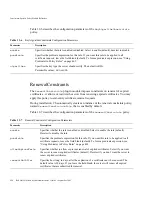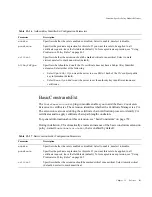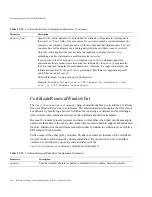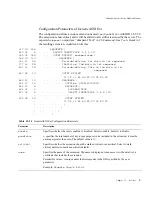
Extension-Specific Policy Module Reference
492
Red Hat Certificate System Administrator’s Guide • September 2005
AuthorityKeyIdentifierExt
The
AuthorityKeyIdentifierExt
plug-in module enables you to add the
Authority Key
Identifier Extension
to certificates. The extension is used to identify the public key that
corresponds to the private key used by a CA to sign certificates.
For general information about this extension, see “authorityKeyIdentifier” on page 731.
For information on setting the subject key identifier extension in certificates, see
“SubjectKeyIdentifierExt” on page 540.
During installation, CS automatically creates an instance of the authority key identifier
extension policy, named
AuthorityKeyIdentifierExt
, that is enabled by default.
•
If you selected
URL
, the value must be a non-relative universal resource identifier (URI)
following the URL syntax and encoding rules. That is, the name must include both a
scheme (for example,
http
) and a fully qualified domain name or IP address of the host.
For example,
http://ocspResponder.example.com:8000
•
If you selected
iPAddress
, the value must be a valid IP address specified in
dot-separated numeric component notation. The syntax for specifying the IP address is as
follows:
IPv4 address must be in the
n.n.n.n
format; for example,
128.21.39.40
. IPv4
address with netmask must be in the
n.n.n.n,m.m.m.m
format. For example,
128.21.39.40,255.255.255.00
.
For IP version 6 (IPv6), the address should be in the form with netmask separated by a
comma. Examples of IPv6 addresses with no netmask are
0:0:0:0:0:0:13.1.68.3
and
FF01::43
. Examples of IPv6 addresses with netmask are
0:0:0:0:0:0:13.1.68.3,FFFF:FFFF:FFFF:FFFF:FFFF:
FFFF:255.255.255.0
and
FF01::43,FFFF:FFFF:FFFF:FFFF:FFFF:FFFF:FF00:0000
.
•
If you selected
OID
, the value must be a unique, valid OID specified in dot-separated
numeric component notation. Although you can invent your own OIDs for the purposes of
evaluating and testing this server, in a production environment, you should comply with
the ISO rules for defining OIDs and for registering subtrees of IDs. See <<<XREF
Appendix B, “Object Identifiers”>>>
for information on allocating private OIDs. For
example,
1.2.3.4.55.6.5.99
.
•
If you selected
otherName
, the value must be the absolute path to the file containing the
base-64 encoded string of the location. For example,
/usr/netscape/servers/ext/aia/othername.txt
.
Table 12-15
AuthInfoAccessExt Configuration Parameters
(Continued)
Parameter
Description
Содержание CERTIFICATE 7.1 ADMINISTRATOR
Страница 1: ...Administrator s Guide Red Hat Certificate System Version7 1 September 2005 ...
Страница 22: ...22 Red Hat Certificate System Administrator s Guide September 2005 ...
Страница 128: ...Cloning a CA 128 Red Hat Certificate System Administrator s Guide September 2005 ...
Страница 230: ...Configuring Key Archival and Recovery Process 230 Red Hat Certificate System Administrator s Guide September 2005 ...
Страница 234: ...Enterprise Security Client 234 Red Hat Certificate System Administrator s Guide September 2005 ...
Страница 368: ...ACL Reference 368 Red Hat Certificate System Administrator s Guide September 2005 ...
Страница 460: ...Constraints Reference 460 Red Hat Certificate System Administrator s Guide September 2005 ...
Страница 592: ...CRL Extension Reference 592 Red Hat Certificate System Administrator s Guide September 2005 ...
Страница 676: ...Cloning the Data Recovery Manager 676 Red Hat Certificate System Administrator s Guide September 2005 ...
Страница 688: ...Security Requirements for the IT Environment 688 Red Hat Certificate System Administrator s Guide September 2005 ...
Страница 720: ...1 3 Organization Security Policies 720 Red Hat Certificate System Administrator s Guide September 2005 ...






























